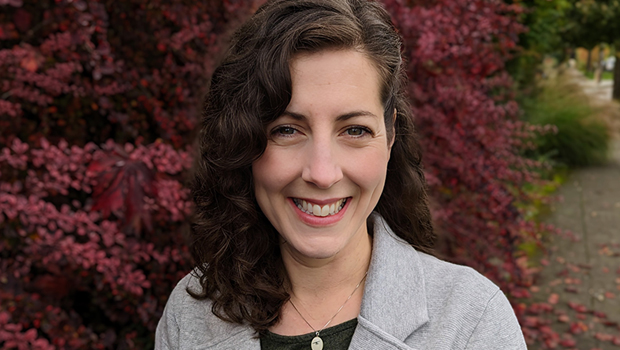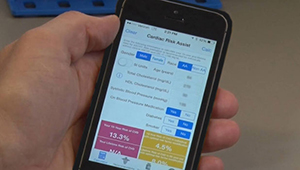New grant boosts research on cardiovascular disease

Epidemiologist Laura B. Harrington speaks about working in cardiovascular and aging research
Earlier this year, Kaiser Permanente Washington Health Research Institute (KPWHRI) Assistant Investigator Laura B. Harrington, PhD, MPH, received a new 5-year, $4 million grant from the National Heart, Lung, and Blood Institute to study complications resulting from venous thromboembolism (VTE). Venous thromboembolism occurs when a blood clot forms in a vein, usually in the legs, arms, or lungs. It is the third most common cardiovascular disease in the United States and can have serious health consequences. Harrington’s research will look at risk factors, symptoms, and clinical outcomes after VTE in a population-based study, with the goal of supporting improved diagnosis and targets for intervention in future work.
Harrington spoke about her career trajectory and her other areas of study as a researcher at KPWHRI. When working in cardiovascular and aging research, she often leads studies about sex-specific risk factors.
How did you start out in your field?
My first experience working in public health was as a college intern at my local health department’s maternal and child health division in my hometown of Lawrence, Kansas. I loved this work, which opened my eyes to the potential to improve health on a population level. My role allowed me to interact directly with women and children; this reinforced for me that I wanted my work to emphasize improving the health of these populations, with a particular focus on the long-term health of women and people born with a uterus. This internship and my first full-time job after college (at a state-level public health nonprofit) exposed me to epidemiology — the study of how often diseases occur in different groups of people and why — and I loved its data-based approach to understanding risk factors for health outcomes on a population level. So, I went back to school for my master’s in public health and then doctorate in epidemiology, starting me on my path toward becoming an epidemiologist.
How have your research interests evolved?
One of my favorite parts about being a scientist is seeing my research interests evolve — sometimes the evolution is unexpected even to me, and it is fun to continuously learn. I started my work as an epidemiologist by concurrently conducting health services research relating to childhood immunizations and epidemiologic research looking at associations between hormonally related exposures and chronic disease outcomes among women and people born with a uterus. My interest in sex hormones brought me to studying risk factors for new and recurrent venous thromboembolism, because the risk of these events is associated with exposure to hormones from medication use, such as oral contraceptives and hormone therapy. There are many interesting and important questions regarding VTE risk for us to answer as scientists. While some of the risk factors for venous thromboembolism are the same as those for blood clots that form in arteries (which can cause heart attacks and strokes), VTE also has many unique risk factors that are incompletely understood.
In addition to my research about venous thromboembolism, I greatly enjoy conducting research relating to sex-specific risk factors for cardiovascular and aging-related outcomes. Historically, sex-specific risk factors have been understudied, and I feel strongly that we need to conduct more research about such factors to better understand these associations and improve the long-term health of women and people born with a uterus.
Why is Kaiser Permanente a good home for your work?
Working at Kaiser Permanente allows me to conduct population-based epidemiologic research because we can leverage health care-based data and data about prescription medications filled, and can conduct additional outreach to our populations of interest if needed. Furthermore, my colleagues here are very interdisciplinary, and I love learning from them. Many of us come from different training backgrounds, and it is so nice to know that I have colleagues with such complementary expertise sitting just down the hall or a short phone or video call away.
What are some current projects you’re excited about?
I am in the midst of conducting several studies evaluating physical activity and sedentary behavior in relation to venous thromboembolism risk. This includes a Kaiser Permanente Washington-based case-crossover study of adults who experienced a venous thromboembolism as well as a study set within the Women’s Health Initiative. Although we know that irregular function of the valves in veins and slow blood flow in the veins are risk factors for venous thromboembolism and can be associated with inactivity, there is an incomplete understanding of whether physical activity and sedentary behaviors are associated with VTE risk.
In addition, I’m incredibly excited about our new inception cohort study of adults who have experienced a venous thromboembolism. We’ll be enrolling participants soon to improve our understanding of patient-relevant symptoms and outcomes of venous thromboembolism. Although venous thromboembolism is typically viewed as an acute (short-term) event, some evidence suggests that there may be important sequelae that occur afterward. This work will help to identify possible modifiable risk factors that could be targeted in future interventions to improve outcomes among adults with venous thromboembolism.
What do you like to do outside of work?
I enjoy spending time with my husband and son and especially love baking, cooking, and eating the delicious fruits and veggies that grow in the Pacific Northwest.
By Amelia Apfel
profile

Heart health researcher Laura B. Harrington joins KPWHRI
KPWHRI gains an expert in studying cardiovascular diseases, including venous blood clots, especially in women and older adults.
Research to practice

Home blood pressure monitoring: From study to clinic
Beverly Green, MD, and Kaiser Permanente work to improve hypertension care.
Research

CVD risk calculation: Can smaller clinics break through?
KPWHRI researchers uncover obstacles faced by smaller practices when adding CVD risk calculators into primary care.


